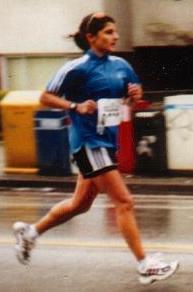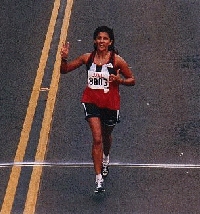| March 2000
Women
in Motion
enhancing female performance Vol 1.
Issue 8 WOMEN
IN MOTION NEWSLETTER - March 2000 This Month Contains: ~Articles ~Words
of Inspiration Pain and the Runner Three
Common Causes Plantar fasciitis is the most common cause of heel pain in runners and non-runners. Plantar fasciitis is an inflammatory reaction to small tears of a large tendon-like structure on the bottom of your foot. These tears are believed to be caused by a combination of a tight achilles tendon and plantar fascia tendon in the face of repetitive loading. This inflammatory process results in the tell-tale symptoms of plantar fasciitis: sharp pain that originates on the bottom of the heel that is most severe after a long period of rest (typically the first few steps in the morning or after long car rides or movies.) This area may be slightly swollen and red, but is always tender to touch. When it comes to treating plantar fasciitis, the news is both good and bad. The good news is that it can almost always be cured without surgery(over 95% in one study); the bad news is that complete resolution of the symptoms may take 1 year. As for running, let pain be your guide. If it hurts, stop. I prescribe a 5-step program for my patients that I have never seen fail in those patients who follow the rules. The steps are: 1. Achilles tendon stretches: the cornerstone of treatment, this must be performed for two to three minutes at least 5 times daily and should endure even after resolution of pain. Healthy feet depend upon a well-stretched achilles tendon 2. Plantar fascia stretches: this should be done for 10 minutes before getting out of bed. Place a towel around the bottom of your foot and gently pull your toes and forefoot towards you with your knee straight 3. Icing of the heel: icing for 10 minutes before bed will reduce you swelling and pain. You need only do this for 2-3 weeks until most of the swelling recedes 4. No barefoot walking: your heels need cushioning to reduce pressure. Keep slippers by your bedside and don't walk without well-padded shoes 5. Heel cups: I prefer over-the-counter silicone heel cups. They are inexpensive, portable from shoe to shoe, and provide the cushioning your heel needs. Most importantly, remember that throughout the process you will have good and bad days. Monitor your progress monthly, not daily. Also, most of your relief will come after the 3rd month of treatment. Don't be impatient. Follow the program. Achilles
Tendinitis is the second most common cause of heel pain
in runners. The cause of achilles tendinitis is
thought to be similar to plantar fasciitis: an
overtight achilles tendon in the face of high repetition
activity. As the tendon begins to wear,
inflammation develops which leads to pain with activity,
redness, tenderness to touch and often a swollen knot in
or around the achilles tendon. One of the best ways
todiscriminate achilles tendinitis from other forms of
heel pain is its location: on the back of the heel (never
on the bottom of the heel) where the achilles tendon
inserts into the heel bone. The most important factor in
treating achilles tendinitis is to control the
inflammation. The inflammation significantly
weakens the tendon, and in chronic cases can predispose
the patient to an achilles tendon rupture (where the
tendon rips off the heel bone completely.) This is
a devastating injury that will require surgery and may
permanently hamper your ability to run. Therefore,
I treat patients with tenderness, redness, swelling, and
pain that causes a limp in a short leg walking cast for
4-8 weeks. Once the inflammation is reduced, I
start them on a devoted achilles tendon stretching
program and give them a heel lift. If the
inflammation is moderate, I prescribe a removable walking
boot for a month then stretching. Mild tendinitis
is treated with icing, a heel lift and achilles tendon
stretches until the pain resolves. Chronic cases
recalcitrant to casting may require surgery.
FROM AROUND THE 'NET 1. CHRONIC
FATIGUE SYNDROME
Whether it is postive or negative
stress, your body responds physically in the same
manner. The body's natural protective technique to handle
a stressor is to use the "fight or flight"
syndrome. As soon as a stressor occurs, adrenaline is
released from the adrenal glands. Your body has moved
into the fight or flight mode. Adrenaline gives you
energy to perform physical acts. The amount of adrenaline
released depends on the intensity of the stressor and
your previous experience with the stressor. Exercise can be lonely, but it is
essential for a healthy mind, body, and spirit. Getting
up early on a cold winter morning to go to the gym
7. INJURY Put your injury on ice If you've
ever been through the injury mill as a runner, you're
probably familiar with the RICE method of injury
recovery: Rest, Ice, Compression, Elevation. Words of Inspiration "I run because I enjoy it
--not always, but most of the time. -Amby Burfoot, marathoner The Running Woman Message Board in Diet and Fitness I just finished checking through some of the old archived posts and discovered that on February 25, 1999, cl-winmotion signed on as the Community Leader for the Running Woman Message Board. There was an anniversary and I missed it! There have been a lot of changes in the past 12 months, and I am proud to be there as they have occurred. Back then we archived every six weeks and now it happens every 1-2 weeks. Many more posts on the board and many more members to welcome. What I have learned in the past 12 months is that it is difficult to post helpful information. Give too much information and people get confused. Give too little information and you can easily be misinterpeted. The trick is to give just the right amount. I'm still learning. The demise of the Running Board in allhealth was reported a short time ago. Well, as of this month, the Walking Board in allhealth has folded. It seems that Diet and Fitness has the only two boards that deal with running and walking. Thanks to all of you for making both of them successes. The Runner's Club has been started and the first one has almost 200 members as of March 1st. The second club has just over 100 members. It was started to catch the overflow and then I went back and increased the membership base from 50 to 400 members. How it develops depends on the membership. The best part of it that I see right now is the ability for members to set up chat times. Good Luck and Good Running Gord
- Women in Motion About This Newsletter A reminder that experts - we are not. Information presented here is a collection of research with a taste of experience and opinion added for flavour. We don't get upset if someone disagrees with anything that has been said or written. In our experience with running groups here at home, it is difficult to get agreement on most anything. If it works for you, then it works. Neither Women in
Motion nor the author of this newsletter provides
professional medical advice. The information in this tip
is intended to help you better understand running issues.
It is not intended to replace the advice of a physician.
If you read something in the newsletter that contradicts
what your physician tells you in any way, always follow
your physician's advice. SUBSCRIBE/UNSUBSCRIBE INFO You are receiving access to this newsletter because you emailed winmotion or cl-winmotion with a running request sometime in the past or joined the mailing list. If you do not wish to have future newletters sent to you, please send an email to: winmotion@ivillage.com using the word "unsubscribe" in the title. If you have any suggestions for topics or questions please email us. We would like to publish a monthly newsletter that reflects the interests of the female runner. Gordon
Samson, Editor LEGAL STUFF / SUBSCRIPTION INFO. "Women in Motion
Newsletter" is free, but its contents are Spread the Word Gordon and Fariyal Samson Practice doesn't make
perfect, perfect practice makes perfect.
|


